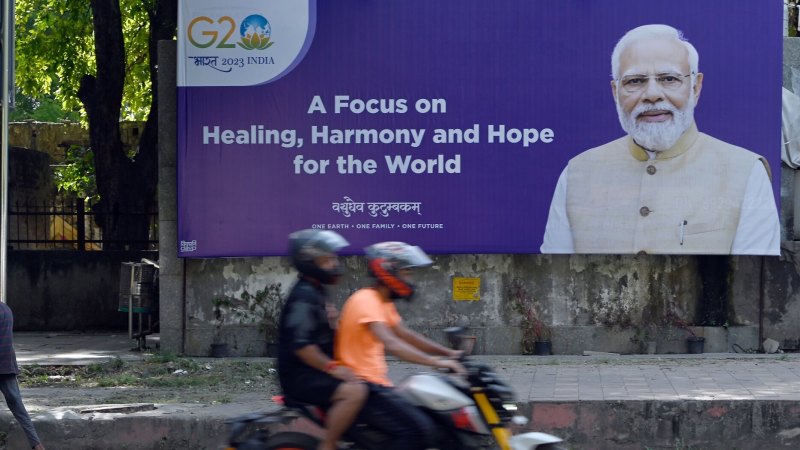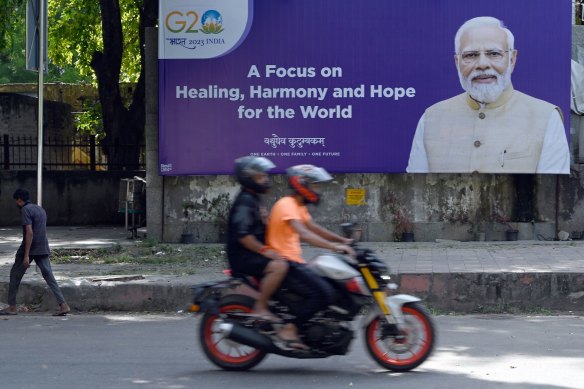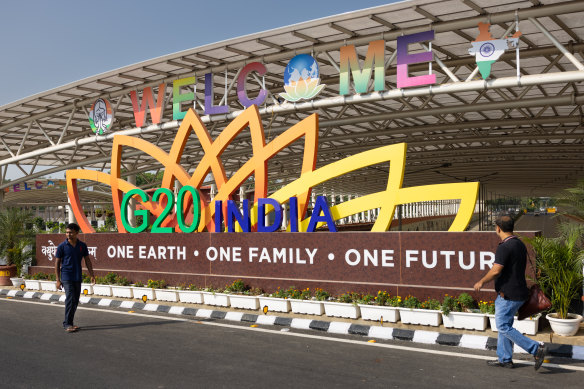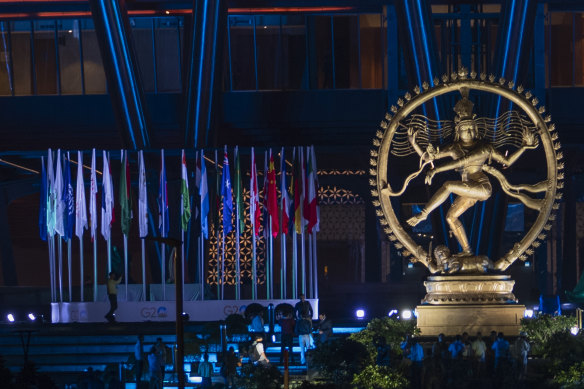
Narendra Modi’s leadership ambitions have been aided by an unlikely adversary
September 9, 2023Save articles for later
Add articles to your saved list and come back to them any time.
What in the World, a free weekly newsletter from our foreign correspondents, is sent every Thursday. Below is an excerpt. Sign up to get the whole newsletter delivered to your inbox.
The arrivals hall at Delhi airport is decked out in G20 billboards flashing pink, yellow and blue. “People progress,” they say. “Let us work together for a new paradigm of human centric cooperation.” At the centre of them all is a beaming Narendra Modi, India’s prime minister and the country’s most powerful politician in a generation.
One of the billboards decorating Delhi ahead of the G20 this week. Credit: Bloomberg
The face of India is now the face of the G20. The exclusive group makes up the world’s 20 largest economies and its leaders are gathering in the Indian capital this week.
The centre of the city has been cleared out to make way for motorcades carrying dignitaries. Retail has been shut down across New Delhi and facial recognition systems have been installed.
“This is a restriction not a lockdown,” government flyers for the two-day summit say amid public rumblings of discontent.
“Concerns about ensuring security smooth passage are legitimate. But to shut down all retail businesses in the zone is going a bit too far and smacks of Potemkin village prep,” India’s Economic Times wrote in an editorial on Tuesday.
Despite the backlash, the Indian government, like all G20 hosts before it, remains determined to plaster over any cracks in its artifice before the VIP jets and travelling media packs touch down on Friday. The prime minister’s principal secretary, Pramod Mishra, has personally issued directions to ensure the weeding of gardens and replacement of dead plants, the watering of flower pots and removal of any dysfunctional street lights before the summit begins.
India, like America, does spectacle well. Unburdened by what might be seen as patriotic cliche in Australia, it embraces all of its natural colour and movement, putting it front and centre for the world to see.
The G20’s rotational presidency, which means each member country hosts the event once every 20 years, could not have come at a more fortunate time for Modi who is preparing to face an election next year for a parliament in which he already controls 353 of 543 seats.
The G20 lotus logo bears a striking resemblance to that of Prime Minister Narendra Modi’s Bharatiya Janata Party.Credit: Getty
India’s choice of G20 logo, a lotus, looks eerily similar to that of Modi’s own party, the Bharatiya Janata Party. It has been plastered on water tanks, schools and tea stalls across the country, from New Delhi to where I am now, in rural Gauchar, on my way through the Himalayas to India’s border with Tibet.
Modi has made no secret of his use of the international forum to advance his nationalistic and domestic political interests. Last week he urged followers on X, formerly known as Twitter, to tweet in Sanskrit about the G20. The Indian leader wants to see the ancient language revived as part of his growing nationalist campaign. This week he went further by replacing the name India with its ancient word Bharat in dinner invitations sent to guests of the G20.
At the same time, the 72-year-old is framing himself not just as a leader of India but of the global south. He has just been aided in that goal by an unlikely adversary, China’s President Xi Jinping, who will skip this year’s summit for the first time since he came to power in 2012. There has been no official reason from Beijing for its leader’s absence, but its ongoing territorial, diplomatic and economic disputes with its largest neighbour, India, may have made Xi reluctant to bestow the pleasure of his company on a country that is becoming one of China’s greatest rivals.
Xi also has pressing issues at home. China’s economy is struggling and consumers and cadres are growing frustrated. Their ideological commitment is wavering. So on Tuesday, Cai Qi, one of his top officials, announced the next stage of the Xi Jinping Thought study campaign, “to fully implement the new era of socialism with Chinese characteristics to condense the heart and soul to achieve new results”.
An illuminated statue of Nataraja, the Hindu god of dance, stands at the entrance of the main venue for the G20 summit in Delhi, India.Credit: AP
It’s unlikely the study sessions on international relations will include many details from the past few weeks. Apart from the G20 no show, those weeks have included the unexplained sacking of China’s foreign minister, the Dutch banning one of the world’s biggest chip suppliers, ASML, from shipping machines to China and Italy saying it will exit Xi’s signature policy, the Belt and Road Initiative. “It will not be a message against China,” said Italian Foreign Minister Antonio Tajani. It is hard to see it being anything but.
When they walk through the arrivals hall, G20 delegates will see another sign next to Modi: “Leave no one behind,” its reads. Except Xi Jinping, a few might be tempted to say.
Get a note directly from our foreign correspondents on what’s making headlines around the world. Sign up for the weekly What in the World newsletter here.
Most Viewed in World
From our partners
Source: Read Full Article




